Electromagnetic Devices: Permanent Magnet and Electromagnet
VerifiedAdded on 2023/02/02
|21
|4565
|33
Homework Assignment
AI Summary
This assignment provides a comprehensive overview of electromagnetic devices, beginning with the fundamental concepts of scalar and vector fields, crucial for understanding the behavior of electric and magnetic phenomena. It then delves into Coulomb's Law, which quantifies the force between charged particles, and Gauss's Law, which relates electric flux to enclosed charge. The document proceeds to discuss permanent magnets and electromagnets, highlighting their properties and differences. Further topics include Biot-Savart Law, which calculates the magnetic field generated by a current-carrying wire, Ampere's Force Law, which determines the force between current-carrying wires, and the characteristics of a toroidal coil. The assignment includes examples and calculations to illustrate these concepts, providing a solid foundation in electromagnetism.

Electromagnetic Devices
Paraphrase This Document
Need a fresh take? Get an instant paraphrase of this document with our AI Paraphraser
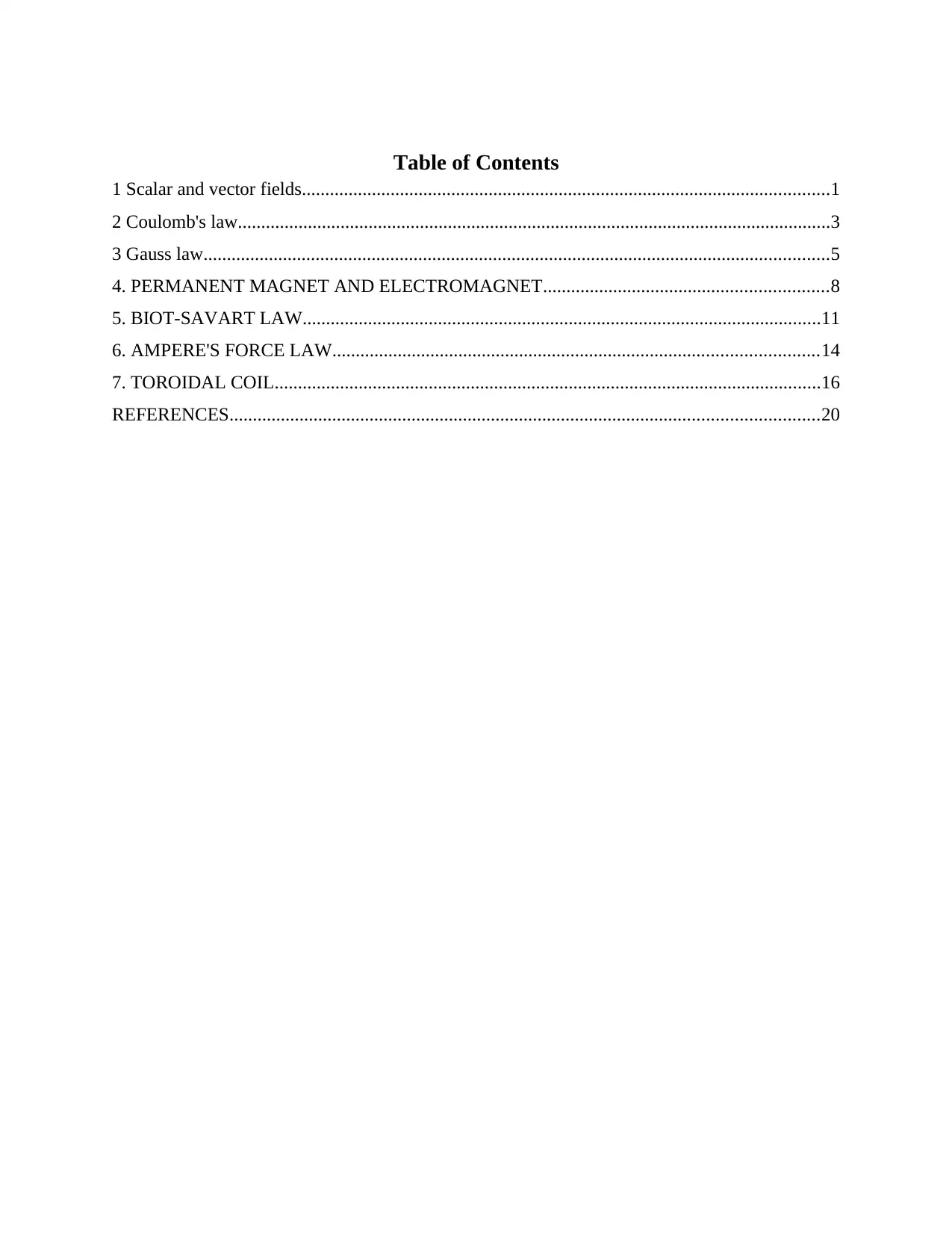
Table of Contents
1 Scalar and vector fields.................................................................................................................1
2 Coulomb's law...............................................................................................................................3
3 Gauss law......................................................................................................................................5
4. PERMANENT MAGNET AND ELECTROMAGNET.............................................................8
5. BIOT-SAVART LAW...............................................................................................................11
6. AMPERE'S FORCE LAW........................................................................................................14
7. TOROIDAL COIL.....................................................................................................................16
REFERENCES..............................................................................................................................20
1 Scalar and vector fields.................................................................................................................1
2 Coulomb's law...............................................................................................................................3
3 Gauss law......................................................................................................................................5
4. PERMANENT MAGNET AND ELECTROMAGNET.............................................................8
5. BIOT-SAVART LAW...............................................................................................................11
6. AMPERE'S FORCE LAW........................................................................................................14
7. TOROIDAL COIL.....................................................................................................................16
REFERENCES..............................................................................................................................20
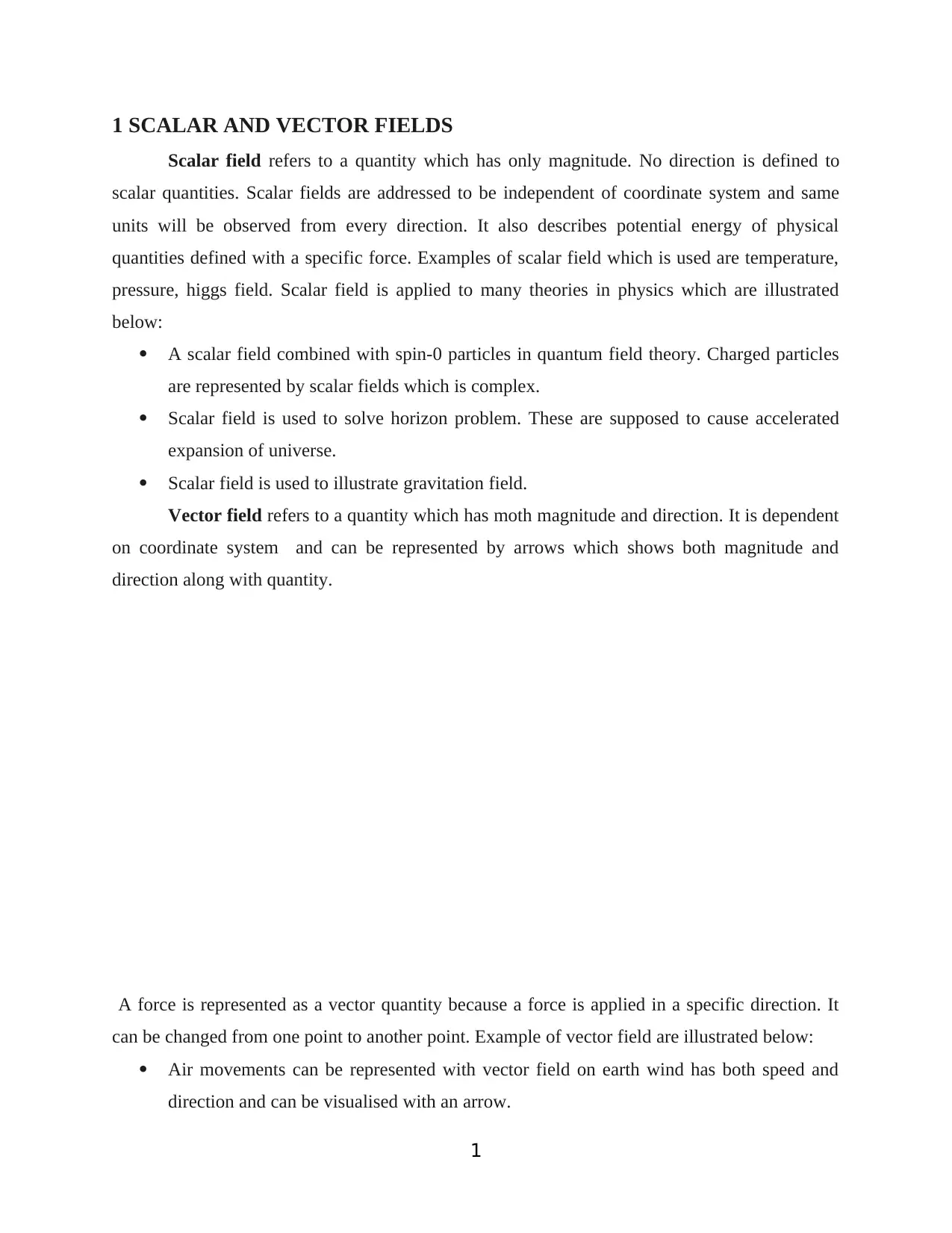
1 SCALAR AND VECTOR FIELDS
Scalar field refers to a quantity which has only magnitude. No direction is defined to
scalar quantities. Scalar fields are addressed to be independent of coordinate system and same
units will be observed from every direction. It also describes potential energy of physical
quantities defined with a specific force. Examples of scalar field which is used are temperature,
pressure, higgs field. Scalar field is applied to many theories in physics which are illustrated
below:
· A scalar field combined with spin-0 particles in quantum field theory. Charged particles
are represented by scalar fields which is complex.
· Scalar field is used to solve horizon problem. These are supposed to cause accelerated
expansion of universe.
· Scalar field is used to illustrate gravitation field.
Vector field refers to a quantity which has moth magnitude and direction. It is dependent
on coordinate system and can be represented by arrows which shows both magnitude and
direction along with quantity.
A force is represented as a vector quantity because a force is applied in a specific direction. It
can be changed from one point to another point. Example of vector field are illustrated below:
· Air movements can be represented with vector field on earth wind has both speed and
direction and can be visualised with an arrow.
1
Scalar field refers to a quantity which has only magnitude. No direction is defined to
scalar quantities. Scalar fields are addressed to be independent of coordinate system and same
units will be observed from every direction. It also describes potential energy of physical
quantities defined with a specific force. Examples of scalar field which is used are temperature,
pressure, higgs field. Scalar field is applied to many theories in physics which are illustrated
below:
· A scalar field combined with spin-0 particles in quantum field theory. Charged particles
are represented by scalar fields which is complex.
· Scalar field is used to solve horizon problem. These are supposed to cause accelerated
expansion of universe.
· Scalar field is used to illustrate gravitation field.
Vector field refers to a quantity which has moth magnitude and direction. It is dependent
on coordinate system and can be represented by arrows which shows both magnitude and
direction along with quantity.
A force is represented as a vector quantity because a force is applied in a specific direction. It
can be changed from one point to another point. Example of vector field are illustrated below:
· Air movements can be represented with vector field on earth wind has both speed and
direction and can be visualised with an arrow.
1
⊘ This is a preview!⊘
Do you want full access?
Subscribe today to unlock all pages.

Trusted by 1+ million students worldwide
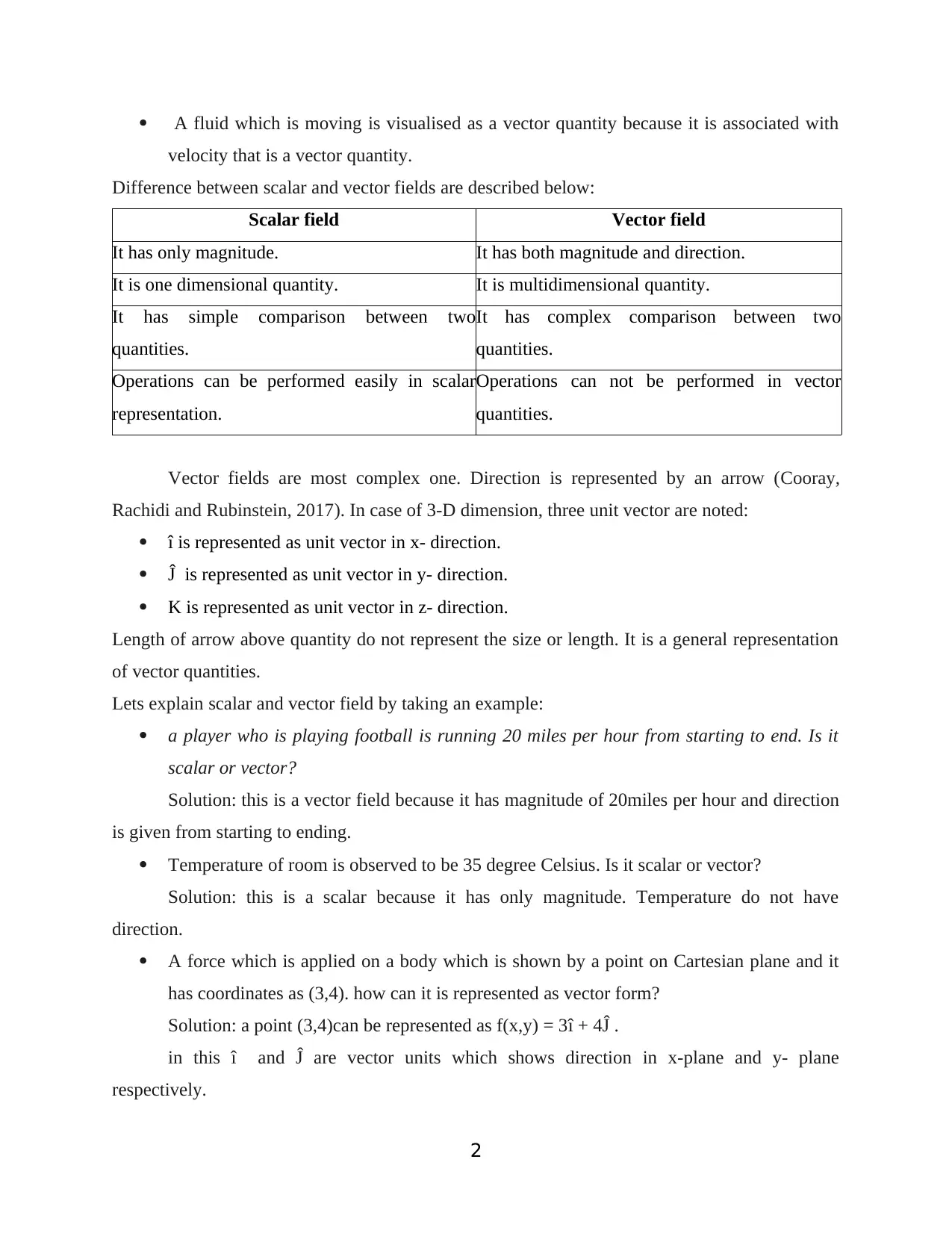
· A fluid which is moving is visualised as a vector quantity because it is associated with
velocity that is a vector quantity.
Difference between scalar and vector fields are described below:
Scalar field Vector field
It has only magnitude. It has both magnitude and direction.
It is one dimensional quantity. It is multidimensional quantity.
It has simple comparison between two
quantities.
It has complex comparison between two
quantities.
Operations can be performed easily in scalar
representation.
Operations can not be performed in vector
quantities.
Vector fields are most complex one. Direction is represented by an arrow (Cooray,
Rachidi and Rubinstein, 2017). In case of 3-D dimension, three unit vector are noted:
· î is represented as unit vector in x- direction.
· Ĵ is represented as unit vector in y- direction.
· K is represented as unit vector in z- direction.
Length of arrow above quantity do not represent the size or length. It is a general representation
of vector quantities.
Lets explain scalar and vector field by taking an example:
· a player who is playing football is running 20 miles per hour from starting to end. Is it
scalar or vector?
Solution: this is a vector field because it has magnitude of 20miles per hour and direction
is given from starting to ending.
· Temperature of room is observed to be 35 degree Celsius. Is it scalar or vector?
Solution: this is a scalar because it has only magnitude. Temperature do not have
direction.
· A force which is applied on a body which is shown by a point on Cartesian plane and it
has coordinates as (3,4). how can it is represented as vector form?
Solution: a point (3,4)can be represented as f(x,y) = 3î + 4Ĵ .
in this î and Ĵ are vector units which shows direction in x-plane and y- plane
respectively.
2
velocity that is a vector quantity.
Difference between scalar and vector fields are described below:
Scalar field Vector field
It has only magnitude. It has both magnitude and direction.
It is one dimensional quantity. It is multidimensional quantity.
It has simple comparison between two
quantities.
It has complex comparison between two
quantities.
Operations can be performed easily in scalar
representation.
Operations can not be performed in vector
quantities.
Vector fields are most complex one. Direction is represented by an arrow (Cooray,
Rachidi and Rubinstein, 2017). In case of 3-D dimension, three unit vector are noted:
· î is represented as unit vector in x- direction.
· Ĵ is represented as unit vector in y- direction.
· K is represented as unit vector in z- direction.
Length of arrow above quantity do not represent the size or length. It is a general representation
of vector quantities.
Lets explain scalar and vector field by taking an example:
· a player who is playing football is running 20 miles per hour from starting to end. Is it
scalar or vector?
Solution: this is a vector field because it has magnitude of 20miles per hour and direction
is given from starting to ending.
· Temperature of room is observed to be 35 degree Celsius. Is it scalar or vector?
Solution: this is a scalar because it has only magnitude. Temperature do not have
direction.
· A force which is applied on a body which is shown by a point on Cartesian plane and it
has coordinates as (3,4). how can it is represented as vector form?
Solution: a point (3,4)can be represented as f(x,y) = 3î + 4Ĵ .
in this î and Ĵ are vector units which shows direction in x-plane and y- plane
respectively.
2
Paraphrase This Document
Need a fresh take? Get an instant paraphrase of this document with our AI Paraphraser
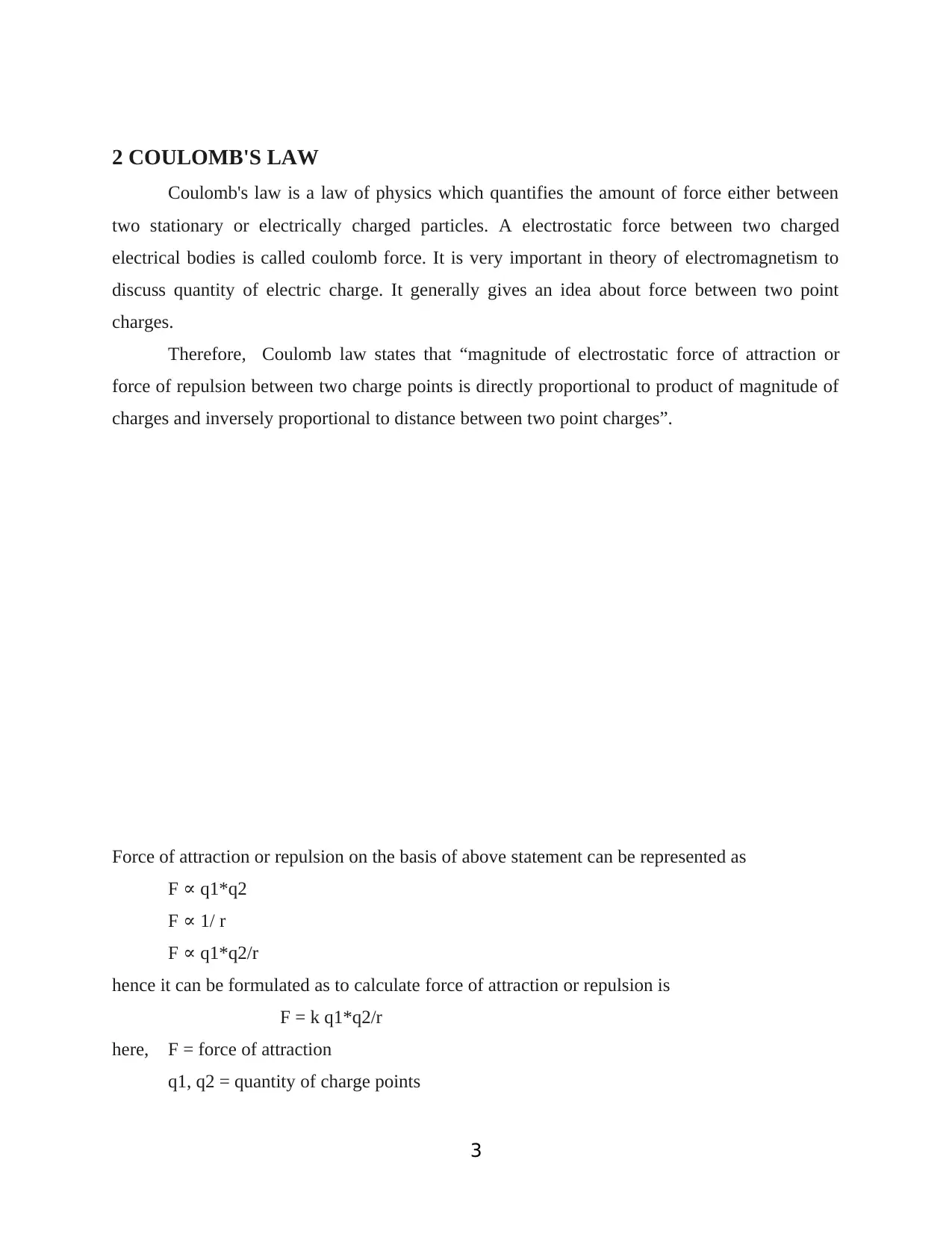
2 COULOMB'S LAW
Coulomb's law is a law of physics which quantifies the amount of force either between
two stationary or electrically charged particles. A electrostatic force between two charged
electrical bodies is called coulomb force. It is very important in theory of electromagnetism to
discuss quantity of electric charge. It generally gives an idea about force between two point
charges.
Therefore, Coulomb law states that “magnitude of electrostatic force of attraction or
force of repulsion between two charge points is directly proportional to product of magnitude of
charges and inversely proportional to distance between two point charges”.
Force of attraction or repulsion on the basis of above statement can be represented as
F q1*q2∝
F 1/ r∝
F q1*q2/r∝
hence it can be formulated as to calculate force of attraction or repulsion is
F = k q1*q2/r
here, F = force of attraction
q1, q2 = quantity of charge points
3
Coulomb's law is a law of physics which quantifies the amount of force either between
two stationary or electrically charged particles. A electrostatic force between two charged
electrical bodies is called coulomb force. It is very important in theory of electromagnetism to
discuss quantity of electric charge. It generally gives an idea about force between two point
charges.
Therefore, Coulomb law states that “magnitude of electrostatic force of attraction or
force of repulsion between two charge points is directly proportional to product of magnitude of
charges and inversely proportional to distance between two point charges”.
Force of attraction or repulsion on the basis of above statement can be represented as
F q1*q2∝
F 1/ r∝
F q1*q2/r∝
hence it can be formulated as to calculate force of attraction or repulsion is
F = k q1*q2/r
here, F = force of attraction
q1, q2 = quantity of charge points
3
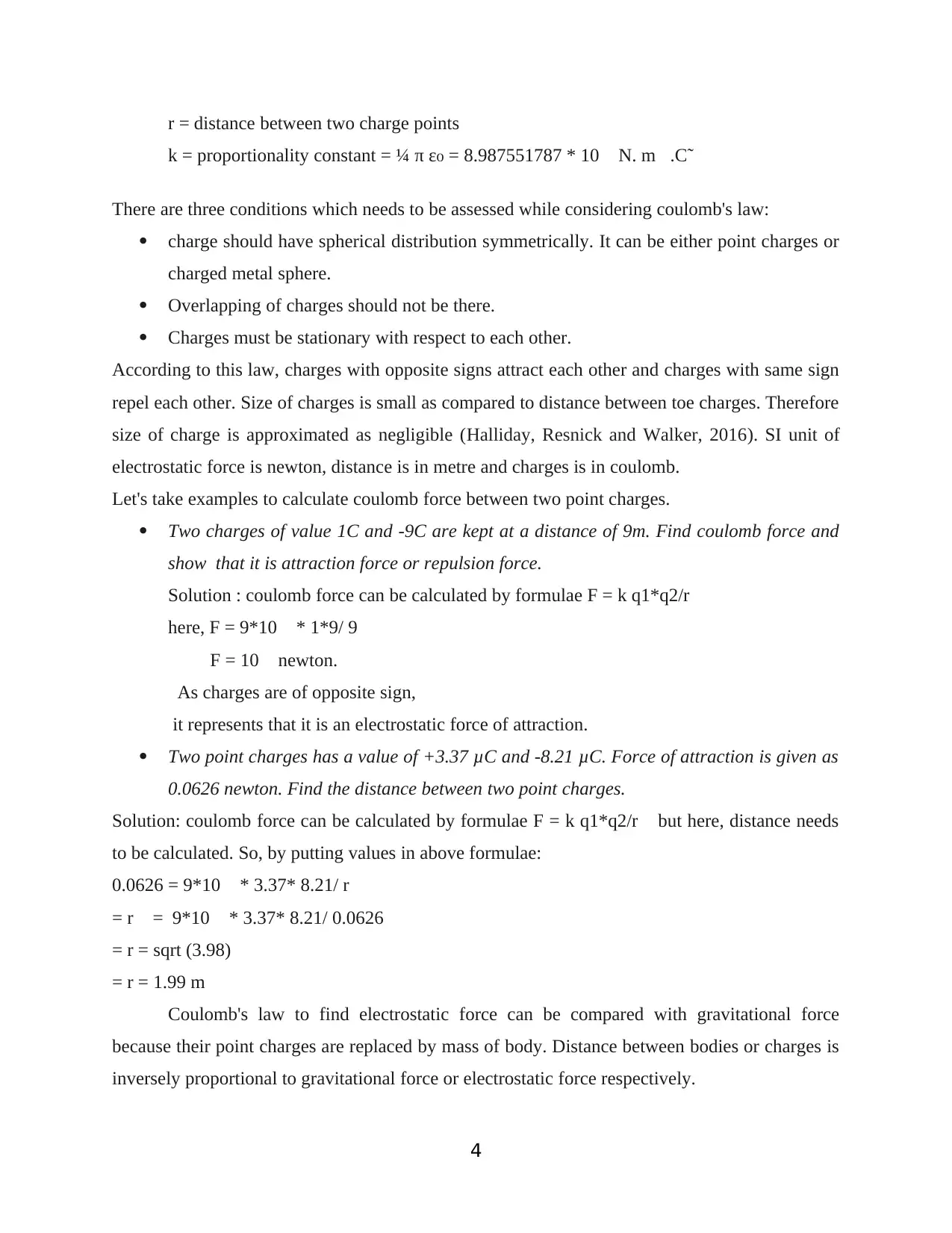
r = distance between two charge points
k = proportionality constant = ¼ π ε = 8.987551787 * 10₀ N. m.C˜
There are three conditions which needs to be assessed while considering coulomb's law:
· charge should have spherical distribution symmetrically. It can be either point charges or
charged metal sphere.
· Overlapping of charges should not be there.
· Charges must be stationary with respect to each other.
According to this law, charges with opposite signs attract each other and charges with same sign
repel each other. Size of charges is small as compared to distance between toe charges. Therefore
size of charge is approximated as negligible (Halliday, Resnick and Walker, 2016). SI unit of
electrostatic force is newton, distance is in metre and charges is in coulomb.
Let's take examples to calculate coulomb force between two point charges.
· Two charges of value 1C and -9C are kept at a distance of 9m. Find coulomb force and
show that it is attraction force or repulsion force.
Solution : coulomb force can be calculated by formulae F = k q1*q2/r
here, F = 9*10 * 1*9/ 9
F = 10 newton.
As charges are of opposite sign,
it represents that it is an electrostatic force of attraction.
· Two point charges has a value of +3.37 μC and -8.21 μC. Force of attraction is given as
0.0626 newton. Find the distance between two point charges.
Solution: coulomb force can be calculated by formulae F = k q1*q2/r but here, distance needs
to be calculated. So, by putting values in above formulae:
0.0626 = 9*10 * 3.37* 8.21/ r
= r = 9*10 * 3.37* 8.21/ 0.0626
= r = sqrt (3.98)
= r = 1.99 m
Coulomb's law to find electrostatic force can be compared with gravitational force
because their point charges are replaced by mass of body. Distance between bodies or charges is
inversely proportional to gravitational force or electrostatic force respectively.
4
k = proportionality constant = ¼ π ε = 8.987551787 * 10₀ N. m.C˜
There are three conditions which needs to be assessed while considering coulomb's law:
· charge should have spherical distribution symmetrically. It can be either point charges or
charged metal sphere.
· Overlapping of charges should not be there.
· Charges must be stationary with respect to each other.
According to this law, charges with opposite signs attract each other and charges with same sign
repel each other. Size of charges is small as compared to distance between toe charges. Therefore
size of charge is approximated as negligible (Halliday, Resnick and Walker, 2016). SI unit of
electrostatic force is newton, distance is in metre and charges is in coulomb.
Let's take examples to calculate coulomb force between two point charges.
· Two charges of value 1C and -9C are kept at a distance of 9m. Find coulomb force and
show that it is attraction force or repulsion force.
Solution : coulomb force can be calculated by formulae F = k q1*q2/r
here, F = 9*10 * 1*9/ 9
F = 10 newton.
As charges are of opposite sign,
it represents that it is an electrostatic force of attraction.
· Two point charges has a value of +3.37 μC and -8.21 μC. Force of attraction is given as
0.0626 newton. Find the distance between two point charges.
Solution: coulomb force can be calculated by formulae F = k q1*q2/r but here, distance needs
to be calculated. So, by putting values in above formulae:
0.0626 = 9*10 * 3.37* 8.21/ r
= r = 9*10 * 3.37* 8.21/ 0.0626
= r = sqrt (3.98)
= r = 1.99 m
Coulomb's law to find electrostatic force can be compared with gravitational force
because their point charges are replaced by mass of body. Distance between bodies or charges is
inversely proportional to gravitational force or electrostatic force respectively.
4
⊘ This is a preview!⊘
Do you want full access?
Subscribe today to unlock all pages.

Trusted by 1+ million students worldwide
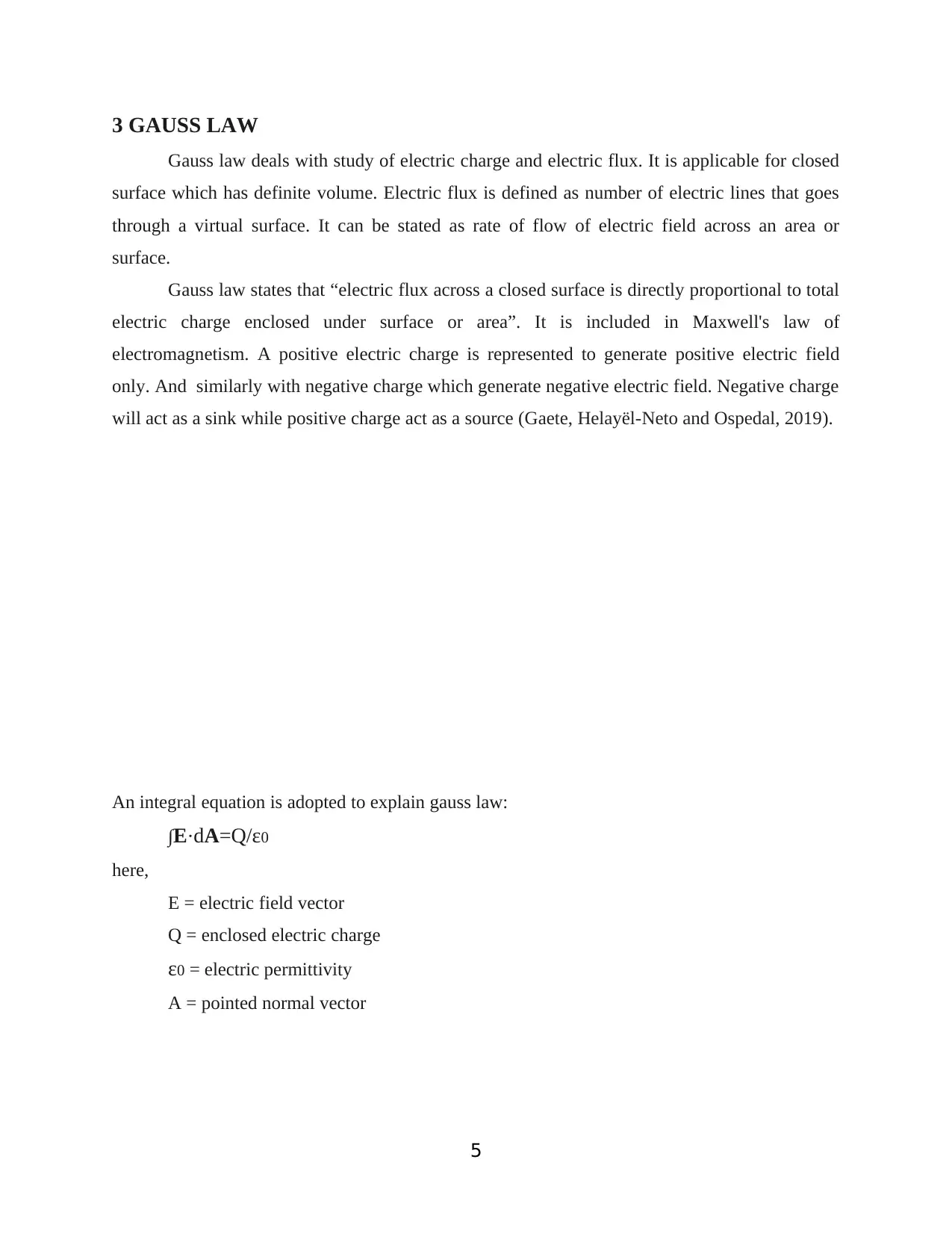
3 GAUSS LAW
Gauss law deals with study of electric charge and electric flux. It is applicable for closed
surface which has definite volume. Electric flux is defined as number of electric lines that goes
through a virtual surface. It can be stated as rate of flow of electric field across an area or
surface.
Gauss law states that “electric flux across a closed surface is directly proportional to total
electric charge enclosed under surface or area”. It is included in Maxwell's law of
electromagnetism. A positive electric charge is represented to generate positive electric field
only. And similarly with negative charge which generate negative electric field. Negative charge
will act as a sink while positive charge act as a source (Gaete, Helayël-Neto and Ospedal, 2019).
An integral equation is adopted to explain gauss law:
∫E⋅dA=Q/ε0
here,
E = electric field vector
Q = enclosed electric charge
ε0 = electric permittivity
A = pointed normal vector
5
Gauss law deals with study of electric charge and electric flux. It is applicable for closed
surface which has definite volume. Electric flux is defined as number of electric lines that goes
through a virtual surface. It can be stated as rate of flow of electric field across an area or
surface.
Gauss law states that “electric flux across a closed surface is directly proportional to total
electric charge enclosed under surface or area”. It is included in Maxwell's law of
electromagnetism. A positive electric charge is represented to generate positive electric field
only. And similarly with negative charge which generate negative electric field. Negative charge
will act as a sink while positive charge act as a source (Gaete, Helayël-Neto and Ospedal, 2019).
An integral equation is adopted to explain gauss law:
∫E⋅dA=Q/ε0
here,
E = electric field vector
Q = enclosed electric charge
ε0 = electric permittivity
A = pointed normal vector
5
Paraphrase This Document
Need a fresh take? Get an instant paraphrase of this document with our AI Paraphraser
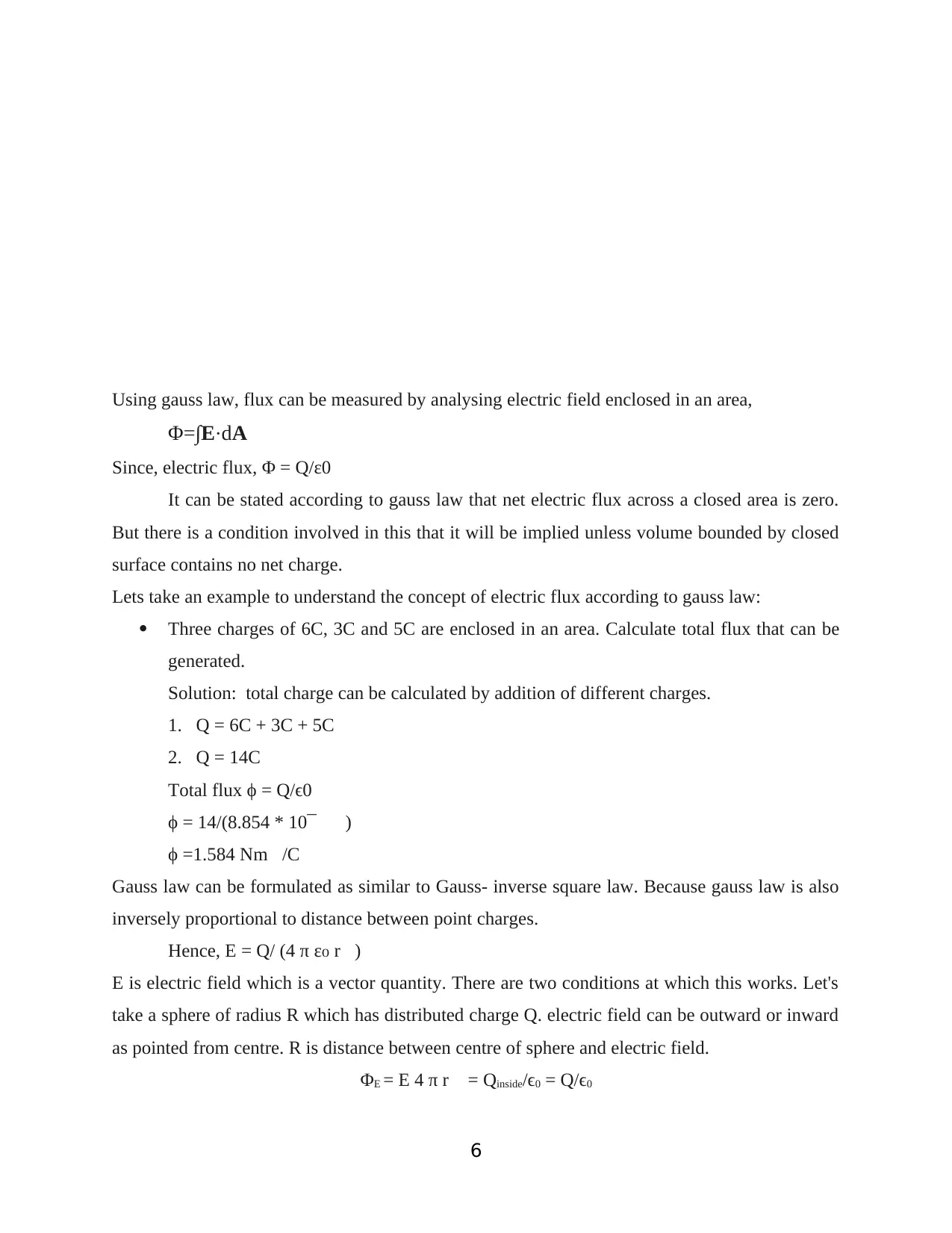
Using gauss law, flux can be measured by analysing electric field enclosed in an area,
Φ=∫E⋅dA
Since, electric flux, Φ = Q/ε0
It can be stated according to gauss law that net electric flux across a closed area is zero.
But there is a condition involved in this that it will be implied unless volume bounded by closed
surface contains no net charge.
Lets take an example to understand the concept of electric flux according to gauss law:
· Three charges of 6C, 3C and 5C are enclosed in an area. Calculate total flux that can be
generated.
Solution: total charge can be calculated by addition of different charges.
1. Q = 6C + 3C + 5C
2. Q = 14C
Total flux ϕ = Q/ϵ0
ϕ = 14/(8.854 * 10¯)
ϕ =1.584 Nm/C
Gauss law can be formulated as similar to Gauss- inverse square law. Because gauss law is also
inversely proportional to distance between point charges.
Hence, E = Q/ (4 π ε₀ r)
E is electric field which is a vector quantity. There are two conditions at which this works. Let's
take a sphere of radius R which has distributed charge Q. electric field can be outward or inward
as pointed from centre. R is distance between centre of sphere and electric field.
ΦE = E 4 π r = Qinside/ϵ0 = Q/ϵ0
6
Φ=∫E⋅dA
Since, electric flux, Φ = Q/ε0
It can be stated according to gauss law that net electric flux across a closed area is zero.
But there is a condition involved in this that it will be implied unless volume bounded by closed
surface contains no net charge.
Lets take an example to understand the concept of electric flux according to gauss law:
· Three charges of 6C, 3C and 5C are enclosed in an area. Calculate total flux that can be
generated.
Solution: total charge can be calculated by addition of different charges.
1. Q = 6C + 3C + 5C
2. Q = 14C
Total flux ϕ = Q/ϵ0
ϕ = 14/(8.854 * 10¯)
ϕ =1.584 Nm/C
Gauss law can be formulated as similar to Gauss- inverse square law. Because gauss law is also
inversely proportional to distance between point charges.
Hence, E = Q/ (4 π ε₀ r)
E is electric field which is a vector quantity. There are two conditions at which this works. Let's
take a sphere of radius R which has distributed charge Q. electric field can be outward or inward
as pointed from centre. R is distance between centre of sphere and electric field.
ΦE = E 4 π r = Qinside/ϵ0 = Q/ϵ0
6
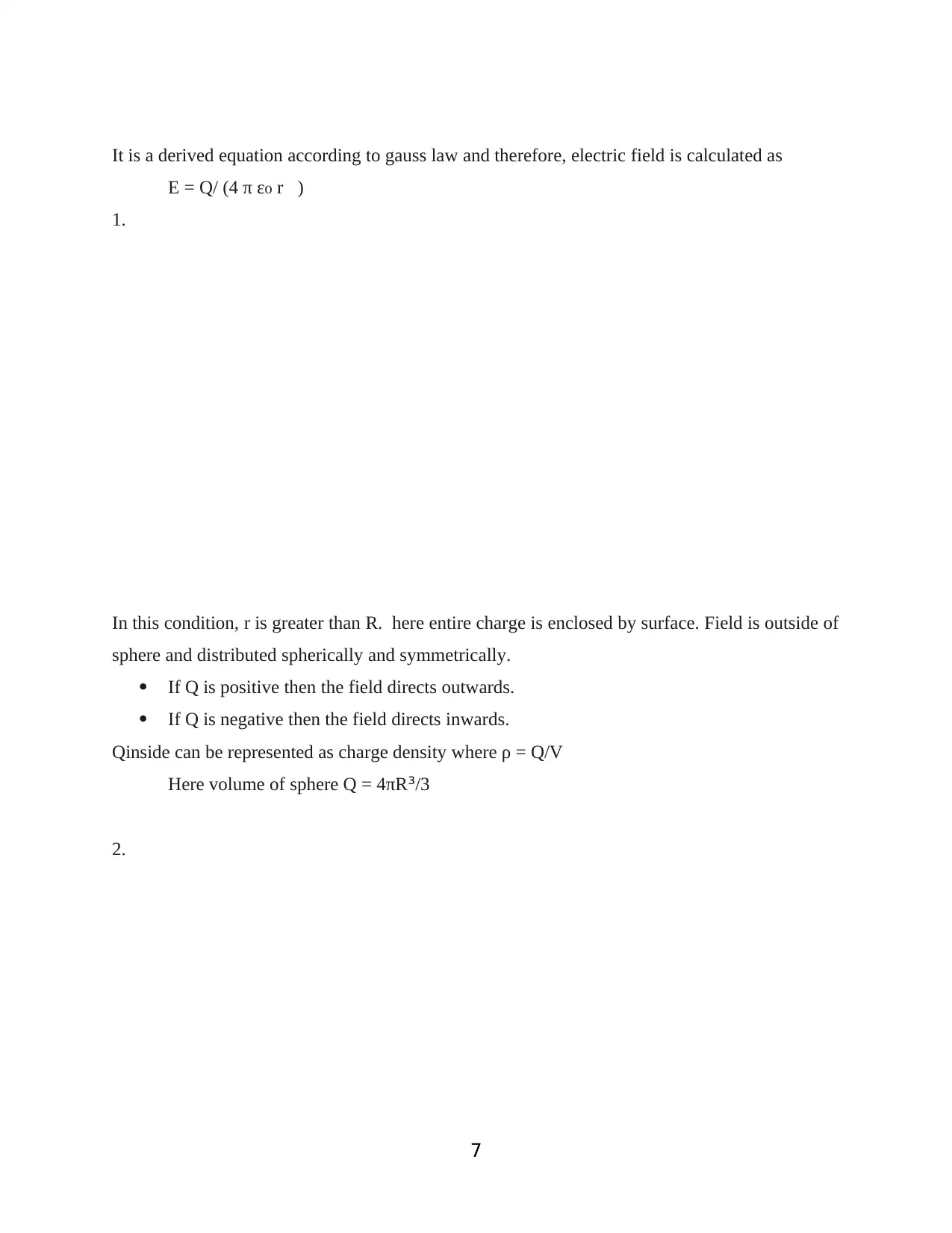
It is a derived equation according to gauss law and therefore, electric field is calculated as
E = Q/ (4 π ε₀ r)
1.
In this condition, r is greater than R. here entire charge is enclosed by surface. Field is outside of
sphere and distributed spherically and symmetrically.
· If Q is positive then the field directs outwards.
· If Q is negative then the field directs inwards.
Qinside can be represented as charge density where ρ = Q/V
Here volume of sphere Q = 4πR³/3
2.
7
E = Q/ (4 π ε₀ r)
1.
In this condition, r is greater than R. here entire charge is enclosed by surface. Field is outside of
sphere and distributed spherically and symmetrically.
· If Q is positive then the field directs outwards.
· If Q is negative then the field directs inwards.
Qinside can be represented as charge density where ρ = Q/V
Here volume of sphere Q = 4πR³/3
2.
7
⊘ This is a preview!⊘
Do you want full access?
Subscribe today to unlock all pages.

Trusted by 1+ million students worldwide
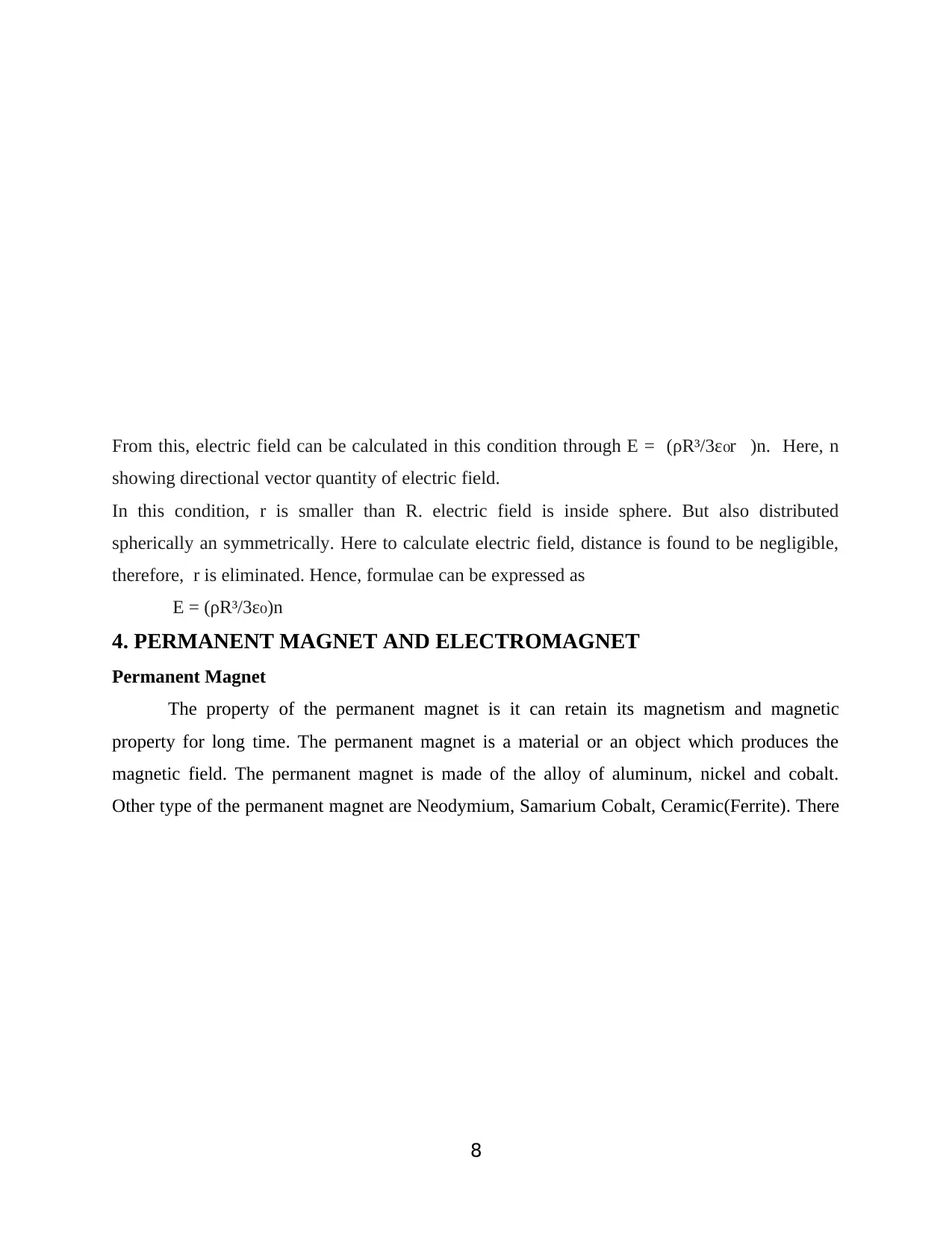
From this, electric field can be calculated in this condition through E = (ρR³/3ε r)n. Here, n₀
showing directional vector quantity of electric field.
In this condition, r is smaller than R. electric field is inside sphere. But also distributed
spherically an symmetrically. Here to calculate electric field, distance is found to be negligible,
therefore, r is eliminated. Hence, formulae can be expressed as
E = (ρR³/3ε )n₀
4. PERMANENT MAGNET AND ELECTROMAGNET
Permanent Magnet
The property of the permanent magnet is it can retain its magnetism and magnetic
property for long time. The permanent magnet is a material or an object which produces the
magnetic field. The permanent magnet is made of the alloy of aluminum, nickel and cobalt.
Other type of the permanent magnet are Neodymium, Samarium Cobalt, Ceramic(Ferrite). There
8
showing directional vector quantity of electric field.
In this condition, r is smaller than R. electric field is inside sphere. But also distributed
spherically an symmetrically. Here to calculate electric field, distance is found to be negligible,
therefore, r is eliminated. Hence, formulae can be expressed as
E = (ρR³/3ε )n₀
4. PERMANENT MAGNET AND ELECTROMAGNET
Permanent Magnet
The property of the permanent magnet is it can retain its magnetism and magnetic
property for long time. The permanent magnet is a material or an object which produces the
magnetic field. The permanent magnet is made of the alloy of aluminum, nickel and cobalt.
Other type of the permanent magnet are Neodymium, Samarium Cobalt, Ceramic(Ferrite). There
8
Paraphrase This Document
Need a fresh take? Get an instant paraphrase of this document with our AI Paraphraser
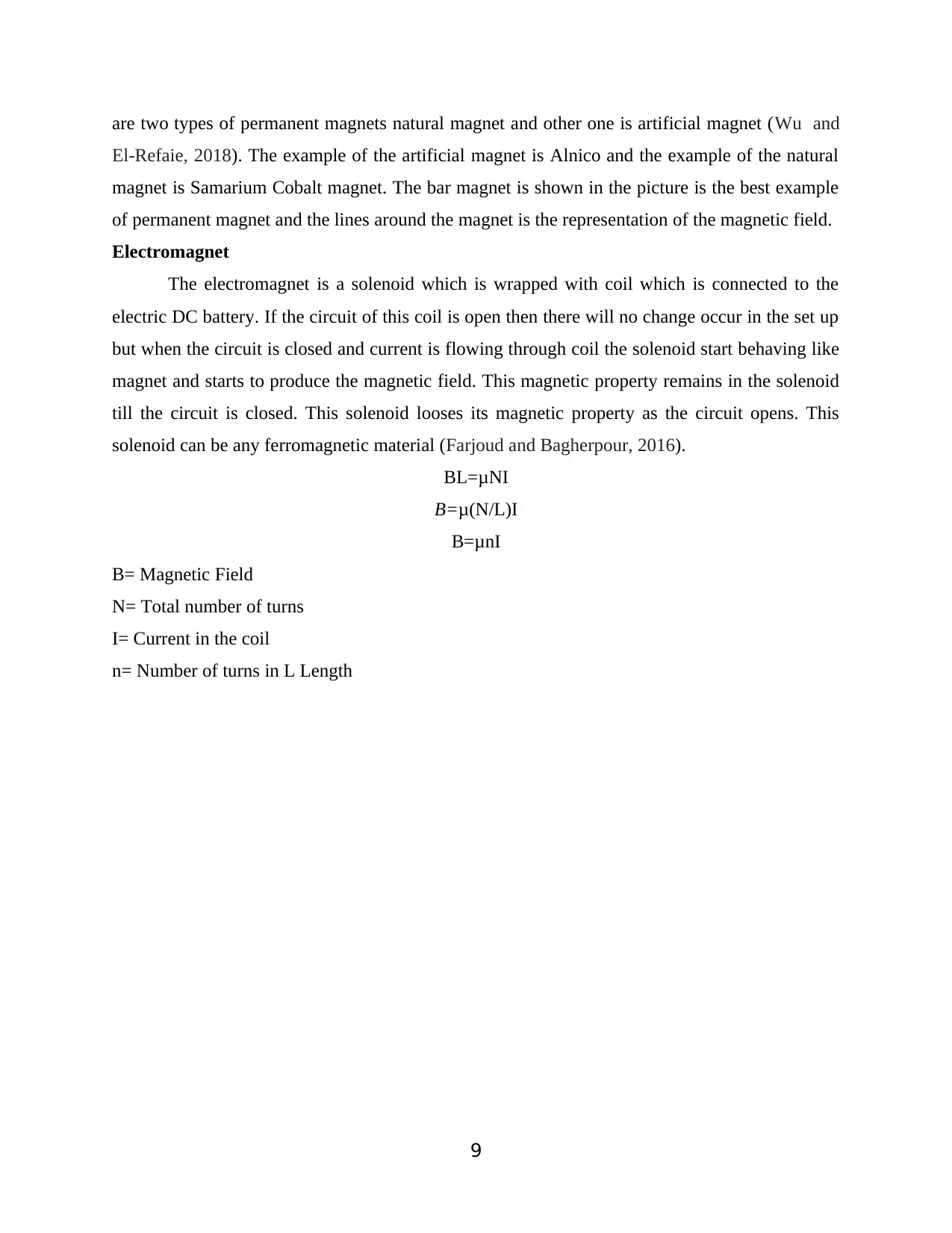
are two types of permanent magnets natural magnet and other one is artificial magnet (Wu and
El-Refaie, 2018). The example of the artificial magnet is Alnico and the example of the natural
magnet is Samarium Cobalt magnet. The bar magnet is shown in the picture is the best example
of permanent magnet and the lines around the magnet is the representation of the magnetic field.
Electromagnet
The electromagnet is a solenoid which is wrapped with coil which is connected to the
electric DC battery. If the circuit of this coil is open then there will no change occur in the set up
but when the circuit is closed and current is flowing through coil the solenoid start behaving like
magnet and starts to produce the magnetic field. This magnetic property remains in the solenoid
till the circuit is closed. This solenoid looses its magnetic property as the circuit opens. This
solenoid can be any ferromagnetic material (Farjoud and Bagherpour, 2016).
BL=μNI
B=μ(N/L)I
B=μnI
B= Magnetic Field
N= Total number of turns
I= Current in the coil
n= Number of turns in L Length
9
El-Refaie, 2018). The example of the artificial magnet is Alnico and the example of the natural
magnet is Samarium Cobalt magnet. The bar magnet is shown in the picture is the best example
of permanent magnet and the lines around the magnet is the representation of the magnetic field.
Electromagnet
The electromagnet is a solenoid which is wrapped with coil which is connected to the
electric DC battery. If the circuit of this coil is open then there will no change occur in the set up
but when the circuit is closed and current is flowing through coil the solenoid start behaving like
magnet and starts to produce the magnetic field. This magnetic property remains in the solenoid
till the circuit is closed. This solenoid looses its magnetic property as the circuit opens. This
solenoid can be any ferromagnetic material (Farjoud and Bagherpour, 2016).
BL=μNI
B=μ(N/L)I
B=μnI
B= Magnetic Field
N= Total number of turns
I= Current in the coil
n= Number of turns in L Length
9
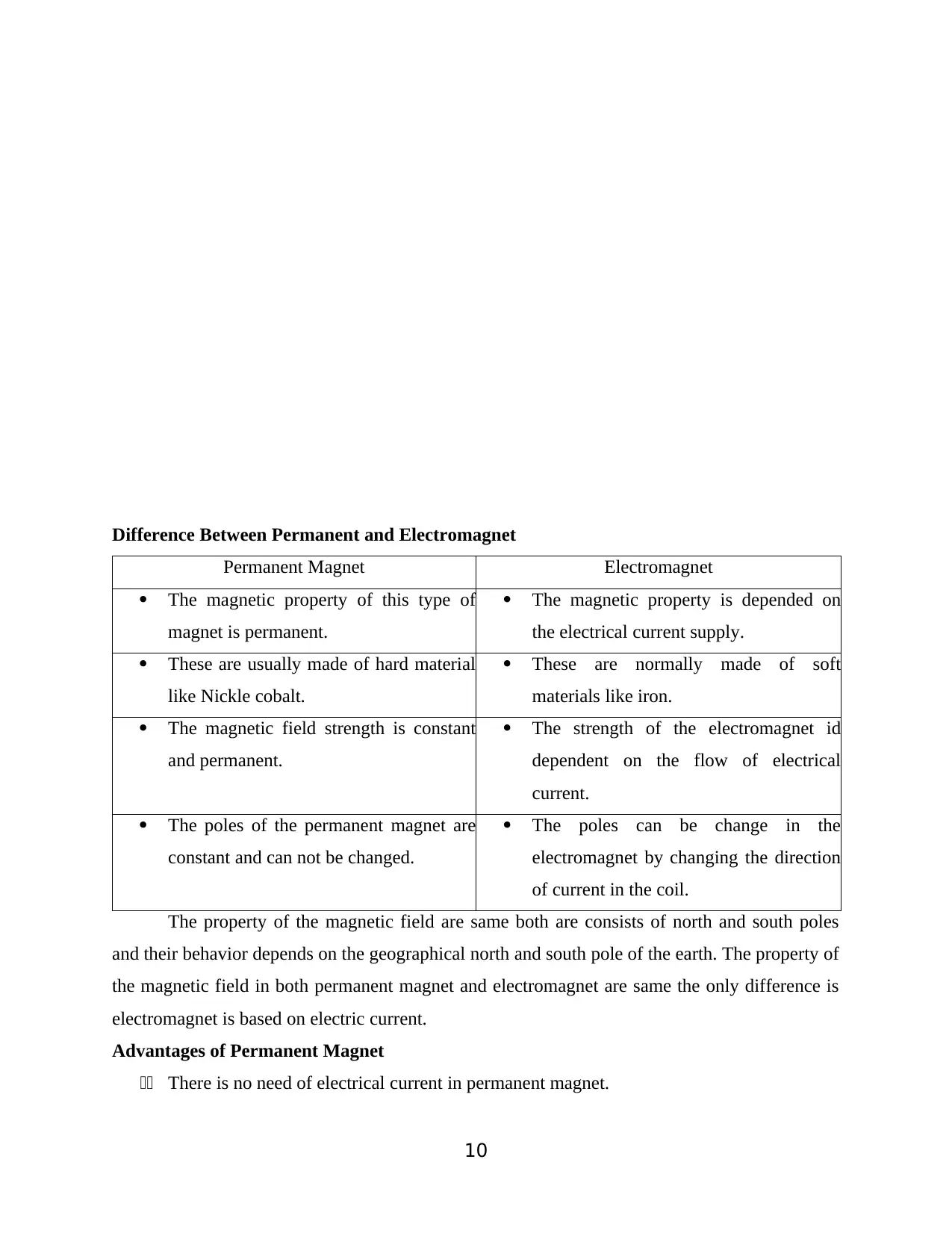
Difference Between Permanent and Electromagnet
Permanent Magnet Electromagnet
· The magnetic property of this type of
magnet is permanent.
· The magnetic property is depended on
the electrical current supply.
· These are usually made of hard material
like Nickle cobalt.
· These are normally made of soft
materials like iron.
· The magnetic field strength is constant
and permanent.
· The strength of the electromagnet id
dependent on the flow of electrical
current.
· The poles of the permanent magnet are
constant and can not be changed.
· The poles can be change in the
electromagnet by changing the direction
of current in the coil.
The property of the magnetic field are same both are consists of north and south poles
and their behavior depends on the geographical north and south pole of the earth. The property of
the magnetic field in both permanent magnet and electromagnet are same the only difference is
electromagnet is based on electric current.
Advantages of Permanent Magnet
11 There is no need of electrical current in permanent magnet.
10
Permanent Magnet Electromagnet
· The magnetic property of this type of
magnet is permanent.
· The magnetic property is depended on
the electrical current supply.
· These are usually made of hard material
like Nickle cobalt.
· These are normally made of soft
materials like iron.
· The magnetic field strength is constant
and permanent.
· The strength of the electromagnet id
dependent on the flow of electrical
current.
· The poles of the permanent magnet are
constant and can not be changed.
· The poles can be change in the
electromagnet by changing the direction
of current in the coil.
The property of the magnetic field are same both are consists of north and south poles
and their behavior depends on the geographical north and south pole of the earth. The property of
the magnetic field in both permanent magnet and electromagnet are same the only difference is
electromagnet is based on electric current.
Advantages of Permanent Magnet
11 There is no need of electrical current in permanent magnet.
10
⊘ This is a preview!⊘
Do you want full access?
Subscribe today to unlock all pages.

Trusted by 1+ million students worldwide
1 out of 21
Related Documents
Your All-in-One AI-Powered Toolkit for Academic Success.
+13062052269
info@desklib.com
Available 24*7 on WhatsApp / Email
![[object Object]](/_next/static/media/star-bottom.7253800d.svg)
Unlock your academic potential
Copyright © 2020–2025 A2Z Services. All Rights Reserved. Developed and managed by ZUCOL.



